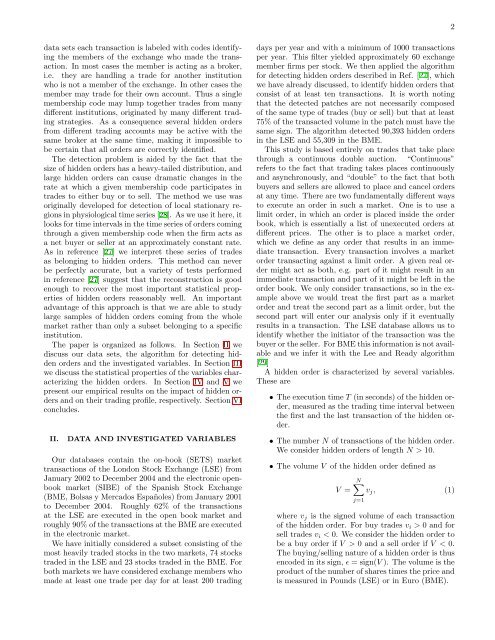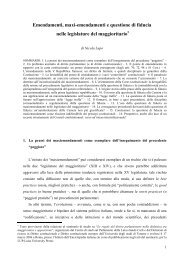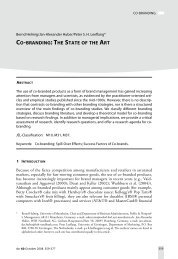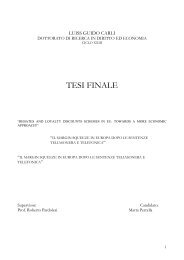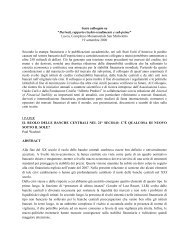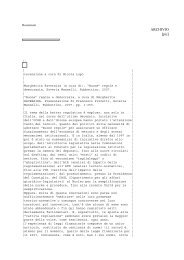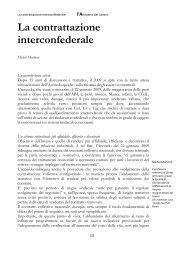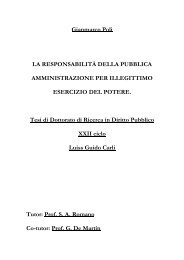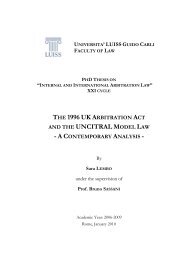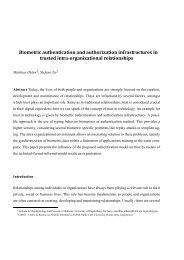Market impact and trading profile of large trading orders in stock ...
Market impact and trading profile of large trading orders in stock ...
Market impact and trading profile of large trading orders in stock ...
You also want an ePaper? Increase the reach of your titles
YUMPU automatically turns print PDFs into web optimized ePapers that Google loves.
2data sets each transaction is labeled with codes identify<strong>in</strong>gthe members <strong>of</strong> the exchange who made the transaction.In most cases the member is act<strong>in</strong>g as a broker,i.e. they are h<strong>and</strong>l<strong>in</strong>g a trade for another <strong>in</strong>stitutionwho is not a member <strong>of</strong> the exchange. In other cases themember may trade for their own account. Thus a s<strong>in</strong>glemembership code may lump together trades from manydifferent <strong>in</strong>stitutions, orig<strong>in</strong>ated by many different <strong>trad<strong>in</strong>g</strong>strategies. As a consequence several hidden <strong>orders</strong>from different <strong>trad<strong>in</strong>g</strong> accounts may be active with thesame broker at the same time, mak<strong>in</strong>g it impossible tobe certa<strong>in</strong> that all <strong>orders</strong> are correctly identified.The detection problem is aided by the fact that thesize <strong>of</strong> hidden <strong>orders</strong> has a heavy-tailed distribution, <strong>and</strong><strong>large</strong> hidden <strong>orders</strong> can cause dramatic changes <strong>in</strong> therate at which a given membership code participates <strong>in</strong>trades to either buy or to sell. The method we use wasorig<strong>in</strong>ally developed for detection <strong>of</strong> local stationary regions<strong>in</strong> physiological time series [28]. As we use it here, itlooks for time <strong>in</strong>tervals <strong>in</strong> the time series <strong>of</strong> <strong>orders</strong> com<strong>in</strong>gthrough a given membership code when the firm acts asa net buyer or seller at an approximately constant rate.As <strong>in</strong> reference [27] we <strong>in</strong>terpret these series <strong>of</strong> tradesas belong<strong>in</strong>g to hidden <strong>orders</strong>. This method can neverbe perfectly accurate, but a variety <strong>of</strong> tests performed<strong>in</strong> reference [27] suggest that the reconstruction is goodenough to recover the most important statistical properties<strong>of</strong> hidden <strong>orders</strong> reasonably well. An importantadvantage <strong>of</strong> this approach is that we are able to study<strong>large</strong> samples <strong>of</strong> hidden <strong>orders</strong> com<strong>in</strong>g from the wholemarket rather than only a subset belong<strong>in</strong>g to a specific<strong>in</strong>stitution.The paper is organized as follows. In Section II wediscuss our data sets, the algorithm for detect<strong>in</strong>g hidden<strong>orders</strong> <strong>and</strong> the <strong>in</strong>vestigated variables. In Section IIIwe discuss the statistical properties <strong>of</strong> the variables characteriz<strong>in</strong>gthe hidden <strong>orders</strong>. In Section IV <strong>and</strong> V wepresent our empirical results on the <strong>impact</strong> <strong>of</strong> hidden <strong>orders</strong><strong>and</strong> on their <strong>trad<strong>in</strong>g</strong> <strong>pr<strong>of</strong>ile</strong>, respectively. Section VIconcludes.II.DATA AND INVESTIGATED VARIABLESOur databases conta<strong>in</strong> the on-book (SETS) markettransactions <strong>of</strong> the London Stock Exchange (LSE) fromJanuary 2002 to December 2004 <strong>and</strong> the electronic openbookmarket (SIBE) <strong>of</strong> the Spanish Stock Exchange(BME, Bolsas y Mercados Españoles) from January 2001to December 2004. Roughly 62% <strong>of</strong> the transactionsat the LSE are executed <strong>in</strong> the open book market <strong>and</strong>roughly 90% <strong>of</strong> the transactions at the BME are executed<strong>in</strong> the electronic market.We have <strong>in</strong>itially considered a subset consist<strong>in</strong>g <strong>of</strong> themost heavily traded <strong>stock</strong>s <strong>in</strong> the two markets, 74 <strong>stock</strong>straded <strong>in</strong> the LSE <strong>and</strong> 23 <strong>stock</strong>s traded <strong>in</strong> the BME. Forboth markets we have considered exchange members whomade at least one trade per day for at least 200 <strong>trad<strong>in</strong>g</strong>days per year <strong>and</strong> with a m<strong>in</strong>imum <strong>of</strong> 1000 transactionsper year. This filter yielded approximately 60 exchangemember firms per <strong>stock</strong>. We then applied the algorithmfor detect<strong>in</strong>g hidden <strong>orders</strong> described <strong>in</strong> Ref. [27], whichwe have already discussed, to identify hidden <strong>orders</strong> thatconsist <strong>of</strong> at least ten transactions. It is worth not<strong>in</strong>gthat the detected patches are not necessarily composed<strong>of</strong> the same type <strong>of</strong> trades (buy or sell) but that at least75% <strong>of</strong> the transacted volume <strong>in</strong> the patch must have thesame sign. The algorithm detected 90,393 hidden <strong>orders</strong><strong>in</strong> the LSE <strong>and</strong> 55,309 <strong>in</strong> the BME.This study is based entirely on trades that take placethrough a cont<strong>in</strong>uous double auction. “Cont<strong>in</strong>uous”refers to the fact that <strong>trad<strong>in</strong>g</strong> takes places cont<strong>in</strong>uously<strong>and</strong> asynchronously, <strong>and</strong> “double” to the fact that bothbuyers <strong>and</strong> sellers are allowed to place <strong>and</strong> cancel <strong>orders</strong>at any time. There are two fundamentally different waysto execute an order <strong>in</strong> such a market. One is to use alimit order, <strong>in</strong> which an order is placed <strong>in</strong>side the orderbook, which is essentially a list <strong>of</strong> unexecuted <strong>orders</strong> atdifferent prices. The other is to place a market order,which we def<strong>in</strong>e as any order that results <strong>in</strong> an immediatetransaction. Every transaction <strong>in</strong>volves a marketorder transact<strong>in</strong>g aga<strong>in</strong>st a limit order. A given real ordermight act as both, e.g. part <strong>of</strong> it might result <strong>in</strong> animmediate transaction <strong>and</strong> part <strong>of</strong> it might be left <strong>in</strong> theorder book. We only consider transactions, so <strong>in</strong> the exampleabove we would treat the first part as a marketorder <strong>and</strong> treat the second part as a limit order, but thesecond part will enter our analysis only if it eventuallyresults <strong>in</strong> a transaction. The LSE database allows us toidentify whether the <strong>in</strong>itiator <strong>of</strong> the transaction was thebuyer or the seller. For BME this <strong>in</strong>formation is not available<strong>and</strong> we <strong>in</strong>fer it with the Lee <strong>and</strong> Ready algorithm[29]A hidden order is characterized by several variables.These are• The execution time T (<strong>in</strong> seconds) <strong>of</strong> the hidden order,measured as the <strong>trad<strong>in</strong>g</strong> time <strong>in</strong>terval betweenthe first <strong>and</strong> the last transaction <strong>of</strong> the hidden order.• The number N <strong>of</strong> transactions <strong>of</strong> the hidden order.We consider hidden <strong>orders</strong> <strong>of</strong> length N > 10.• The volume V <strong>of</strong> the hidden order def<strong>in</strong>ed asV =N∑v j , (1)j=1where v j is the signed volume <strong>of</strong> each transaction<strong>of</strong> the hidden order. For buy trades v i > 0 <strong>and</strong> forsell trades v i < 0. We consider the hidden order tobe a buy order if V > 0 <strong>and</strong> a sell order if V < 0.The buy<strong>in</strong>g/sell<strong>in</strong>g nature <strong>of</strong> a hidden order is thusencoded <strong>in</strong> its sign, ɛ = sign(V ). The volume is theproduct <strong>of</strong> the number <strong>of</strong> shares times the price <strong>and</strong>is measured <strong>in</strong> Pounds (LSE) or <strong>in</strong> Euro (BME).


